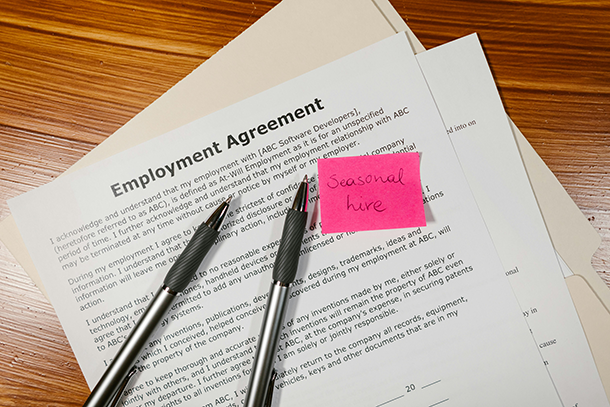Quick Access
Looking for something specific? Jump to the topic by clicking the links below.
H-2B VISA: HIRE SEASONAL AND TEMPORARY WORKERS AT Burgos Law
If your business gets busier during certain times of the year—or you hit short-term surges that your regular team just can’t cover—the H-2B visa may be exactly what you need. This visa allows U.S. employers to hire foreign workers for temporary, non-agricultural jobs tied to seasonal or peak load demand. It is a popular option for businesses in landscaping, hospitality, construction, food service, and event staffing – just to name a few.
Whether you’re preparing for your annual busy season or facing a spike in projects, we’ll help you navigate the H-2B process with confidence—so you can build the team you need, right when you need it.
H-2B VISA SEASONAL vs. PEAK-LOAD: What's the Difference?
When applying for H-2B visas, your “temporary need” must fall into one of four categories. The two most common—and easiest to understand—are seasonal and peak-load.
Seasonal Need: The Same Busy Season Every Year
A seasonal need happens when your business requires extra help during a specific time of year, every year. This is often due to natural or predictable patterns like weather, holidays, or tourism cycles.
Examples of Seasonal Need:
- A landscaping company that gets busy every spring and summer but slows down in the winter.
- A beach resort that only operates fully during the summer tourist season.
- A Christmas light installation business that operates from October through January.
- A ski lodge that needs additional staff during the winter months.
Important: The job can’t be year-round. It must be tied to a specific, recurring season, and you won’t need these same positions filled all 12 months.
Peak-Load Need: Temporary Surge in Demand
A peak-load need happens when your business is usually staffed year-round—but sometimes, your normal team just isn’t enough to handle the workload. You’re not replacing U.S. workers—you’re adding temporary help to support your core team during the busiest times.
Examples of Peak-Load Need:
- A construction company that takes on large summer projects that exceed normal staffing capacity.
- A hotel or event venue that hosts more weddings and corporate events during spring and fall.
- A distribution company that gets flooded with orders during the holiday shopping season.
Important: You must show that this is a short-term spike, and you’ll return to regular staffing levels once it ends.
COMMON PITFALLS AND HOW WE HELP YOU Avoid Them
Hiring for a permanent position?
Replacing U.S. workers?
Vague plans?
We help you present a strong, compliant case by documenting your seasonal or peak-load need with the right language and proof—like contracts, schedules, or sales data.
IS THE H-2B VISA A LOTTERY? HERE'S WHAT YOU Need to Know
Yes, the H-2B visa is a lottery. That means just applying isn’t enough—timing, strategy, and flawless paperwork matter. Here’s the breakdown
33,000 visas for jobs starting October 1 to March 31
- 33,000 visas for jobs starting April 1 to September 30
When more applications are submitted than visas available on the first day of filing, the Department of Labor holds a random lottery to decide who gets to move forward. That’s why filing on Day 1 is critical—and why we build your case early and get it right the first time.
When Should You Start the H-2B Visa Process?
To have the best shot in the lottery, you should start preparing 5–6 months in advance of your hiring window. Waiting too long could cost you the chance to hire.
- Want workers starting April 1? Start the process by October of the previous year.
- Want workers starting October 1? Start planning by April of the same year.

HOW WE HELP YOU Succeed
We don’t just “file paperwork.” We partner with you to create a visa strategy that fits your business. When you work with us, we:
✔️Identify whether your need is seasonal or peak-load
✔️Craft a compelling and accurate narrative for government review
✔️Submit your DOL and USCIS filings on time
✔️Keep you informed through every stage of the process
✔️Help you plan for future filing seasons to stay ahead
Let’s Bring Your Workforce to Life – Together
You’re busy running your business. Let us handle the H-2B process so you can get the people you need—on schedule, on budget, and without compliance headaches.
Schedule a Strategy Session Today
We’ll walk you through the process and build a personalized plan for your hiring needs.
FAQs
What’s the difference between H-2A and H-2B?
H-2A is for agricultural work (like farms), while H-2B is for non-agricultural jobs (like landscaping, hospitality, and construction).
How long does the process take?
It can take 4 to 6 months, so early preparation is critical. We recommend starting 6+ months in advance of your intended employment start date.
Can the worker bring their family?
Yes. Spouses and unmarried children under 21 can apply for H-4 visas, but they cannot work in the U.S. under this status.
Do workers need to be outside the U.S.?
Not necessarily. Workers already in the U.S. under certain statuses may be eligible for a change of status, but consular processing is more common.
What happens if I’m not selected in the lottery?
We help you build a Plan B, so you’re not left scrambling if the lottery doesn’t go your way. Planning early helps you explore all options.
How many workers can I apply for under the H-2B program?
There’s no official limit on how many workers you can request, but you’ll need to justify the number based on your temporary need.
Can I use the H-2B program every year?
Yes! Many of our clients are repeat H-2B users who file petitions annually. If your busy season is consistent (like every summer or holiday season), we can help you build a recurring strategy so you’re always prepared to meet demand.
What if I miss the lottery or the cap is reached?
Unfortunately, once the cap is hit, no more visas are available—unless extra spots are released by the government. That’s why early planning and filing on day one are so important. We’ll also help you explore Plan B options, such as alternative visa categories or planning ahead for the next filing season.

